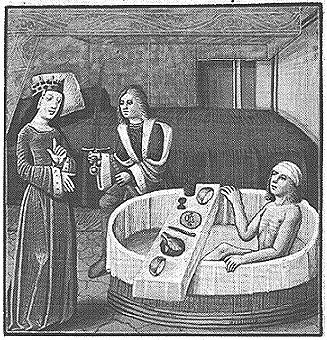| Bet you didn't know some of this either.... | ||

|
Some interesting bits of history concerning bathing and bathtubs
|
|
I've always heard that, previous to the last hundred years or so, humankind was not overly concerned about personal cleanliness. After doing a little research I have learned some surprising things! Did you know that a glazed ceramic pedestal bathtub---much similar to the design we sell today, was found by archeologists on the island of Crete and was last used almost 3000 years ago! And they were not alone amongst our distant ancestors. Cultures in India, China, Japan, Egypt and elsewhere developed elaborate systems for bathing. And one mustn't forget what we learned in school about the Romans and their amazing aqueducts that supplied water to the baths. Now on to the Middle Ages Even in the Middle Ages when life was hard, cleanliness was sought after. Society demanded that one wash hands and face and rinse the mouth each morning, and change linen regularly. Soap began to be used around 1200 although it was not yet like the soap we know today and it was a luxury item. And the Church.... The Church thought bathing was good if it was kept brief and occurred on a Sunday. What they disapproved of were the "stews" or communal bath houses that served both men and women of the general population. Food was even served there---laid out on planks across the huge tubs of hot water. For a couple of years laws were passed that forbade the women in ornate hats and jewelry from using the stews. Seems the relaxing nature of a warm bath, clean body and a full belly was conducive of other activities and the hat and jewelry ladies made a good living. Clean, too! Listen for the bathhouse trumpets! Another interesting thing I read about the bathhouses ---When the public bathhouses opened in the mornings they would be announced with trumpets and drums. Then the parade of townsmen would commence--as often as not stark naked to protect themselves from theft whilst in the bath! Medieval manor house bathing---a social occasion Back at the manor house or castle there might be a special room off the kitchen, made especially for the ladies to have bathing parties. The water would be perfumed or have rose petals or nice smelling herbs added. Here the ladies could sit on stools in the great tubs of hot water and wear their jewels and finest head dresses without being mistaken for working women. And here. too, food would be laid out on planks---quite an agreeable social occasion. Is it a bath or a swimming pool? There was an amazing bathing room constructed at Leeds Castle in England in 1291. It was a huge 23 ft by 17 ft, lined with stone and could hold 4 feet of water taken from the lake that surrounded the castle. Well thought out, it had a ledge for accessories, a recess for the bath and a nearby changing room. In some of the castles, bathing rooms even had piped-in hot and cold water. The Lord of the Manor For the lords, the bathing situation was similar but more solitary and usually took place in their bed chamber. Medieval man did love his baths and probably took more of them than his relatives of the 19th century. But there were notable exceptions. It was said of Brun, brother to Otto the Great of Germany, "When he took a bath, he hardly ever used any soap or preparations to make his skin shiny, which is even more surprising, since he was familiar with such cleansing methods and royal comforts from early childhood." The Bathman When the weather was nice, the tubs were taken into the garden and perhaps shielded by a canopy or tent. Winters found the tubs by the fireside. What's interesting is that there was a position in the manor house called a "bathman" whose sole responsibility was preparing baths for the family . And when the lord traveled he would take along his tub---and the bathman. Banquet and wedding feast baths! It does seem to be true that bathing was often more important socially than in the pursuit of cleanliness. The Church has recorded that baths were used for social affairs such as banquets and wedding feasts. Can you imagine! The decline of the stew It was during the 1400-1600's that the number of bath houses gradually declined for several reasons. They became crime ridden, wood became too expensive to heat the water, diseases like the syphilis began to spread and the Church was against them for moral reasons. And public opinion was that diseases could enter your body thru open pores---just what would happen after a warm bath or steam bath. They also had to consider so many people being together in close quarters. The first of the Great Plagues taught that this might not be a good idea. So they took the Church's recommendation of a quick rinse now and then--- with the skin to be carefully patted dry immediately. Some came to think of now and then as meaning once a month--once a year---perhaps even once every few years. Eventually science once again swung thought in the opposite direction. And here we are today.... |
||